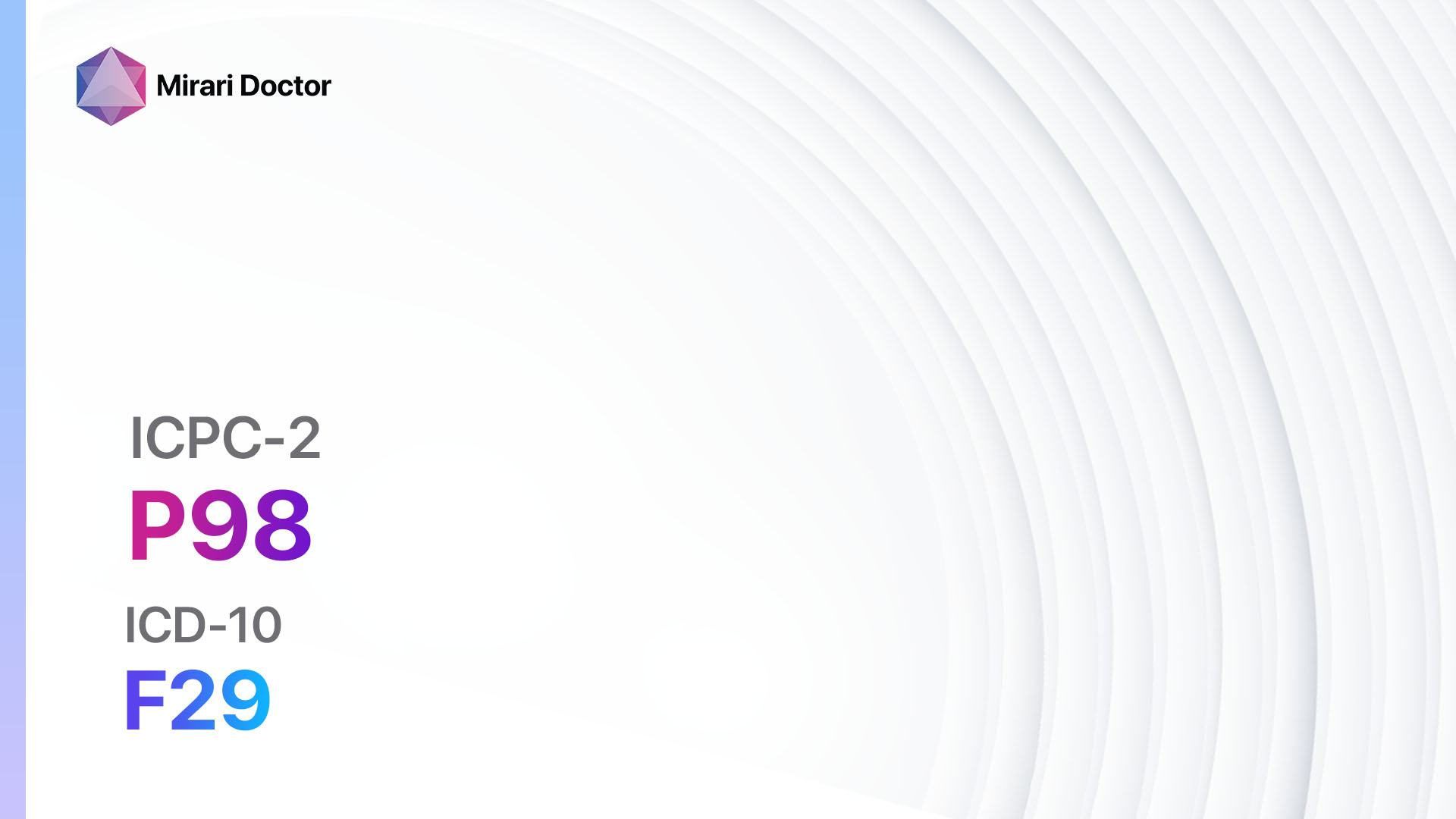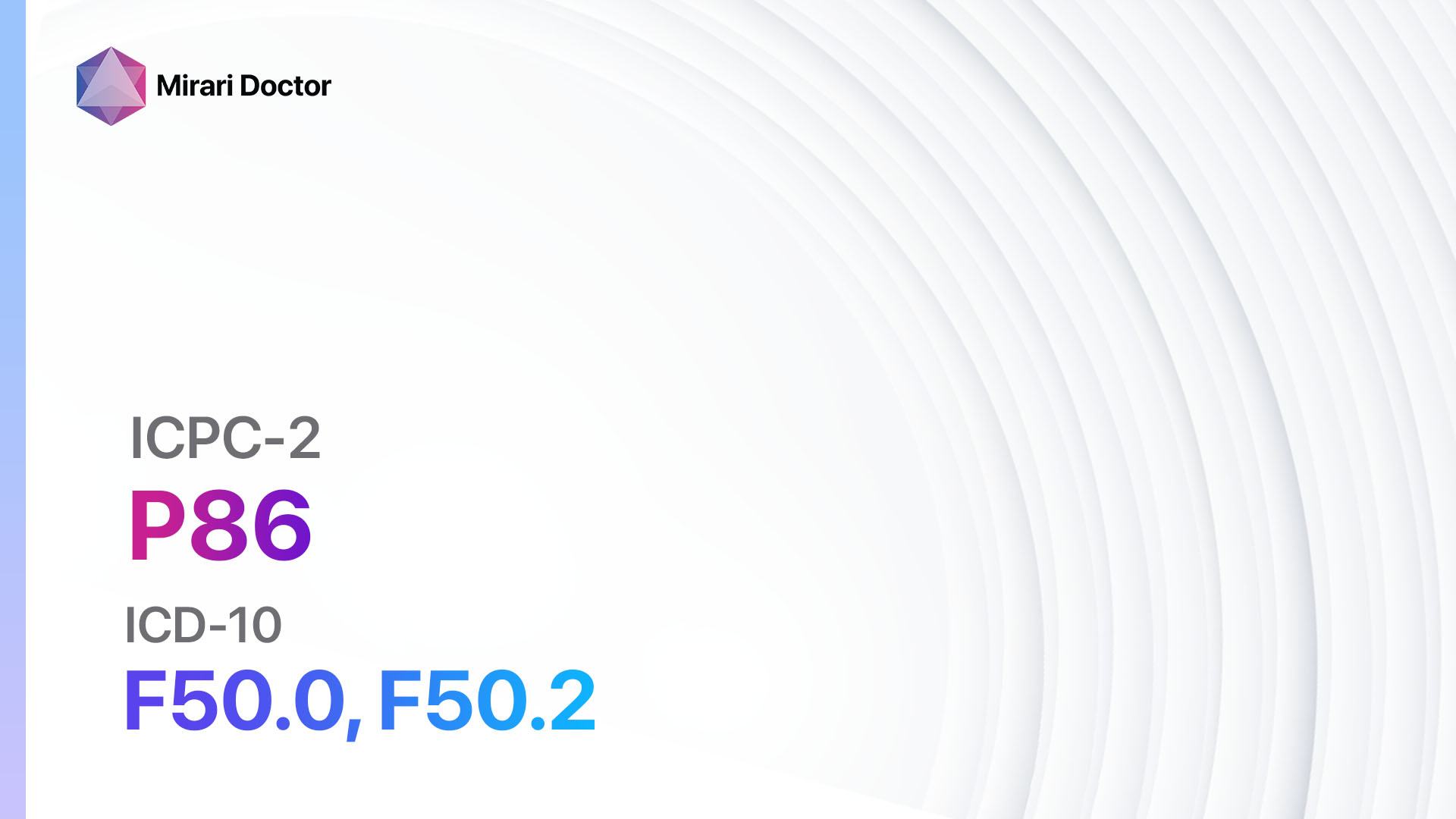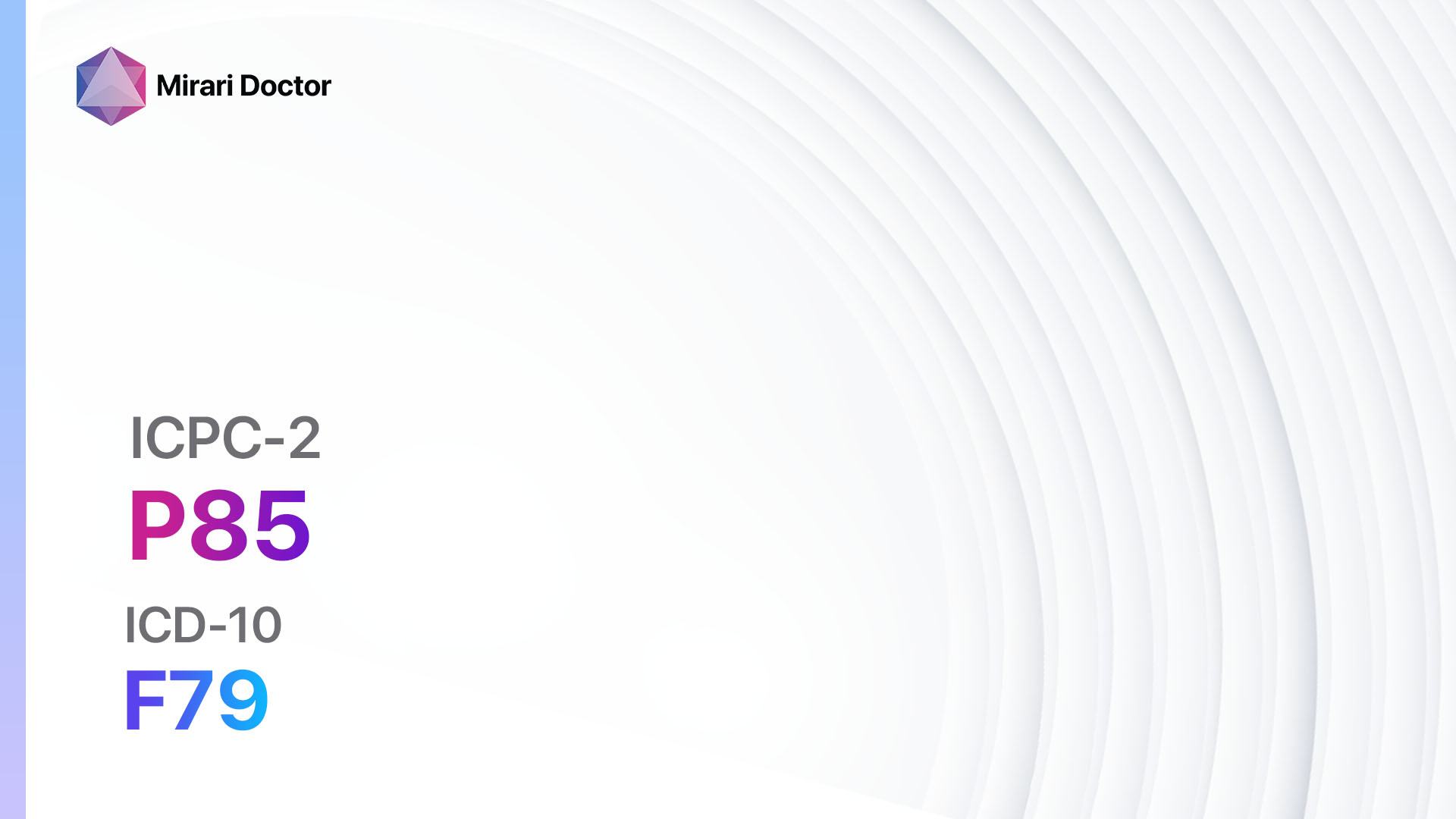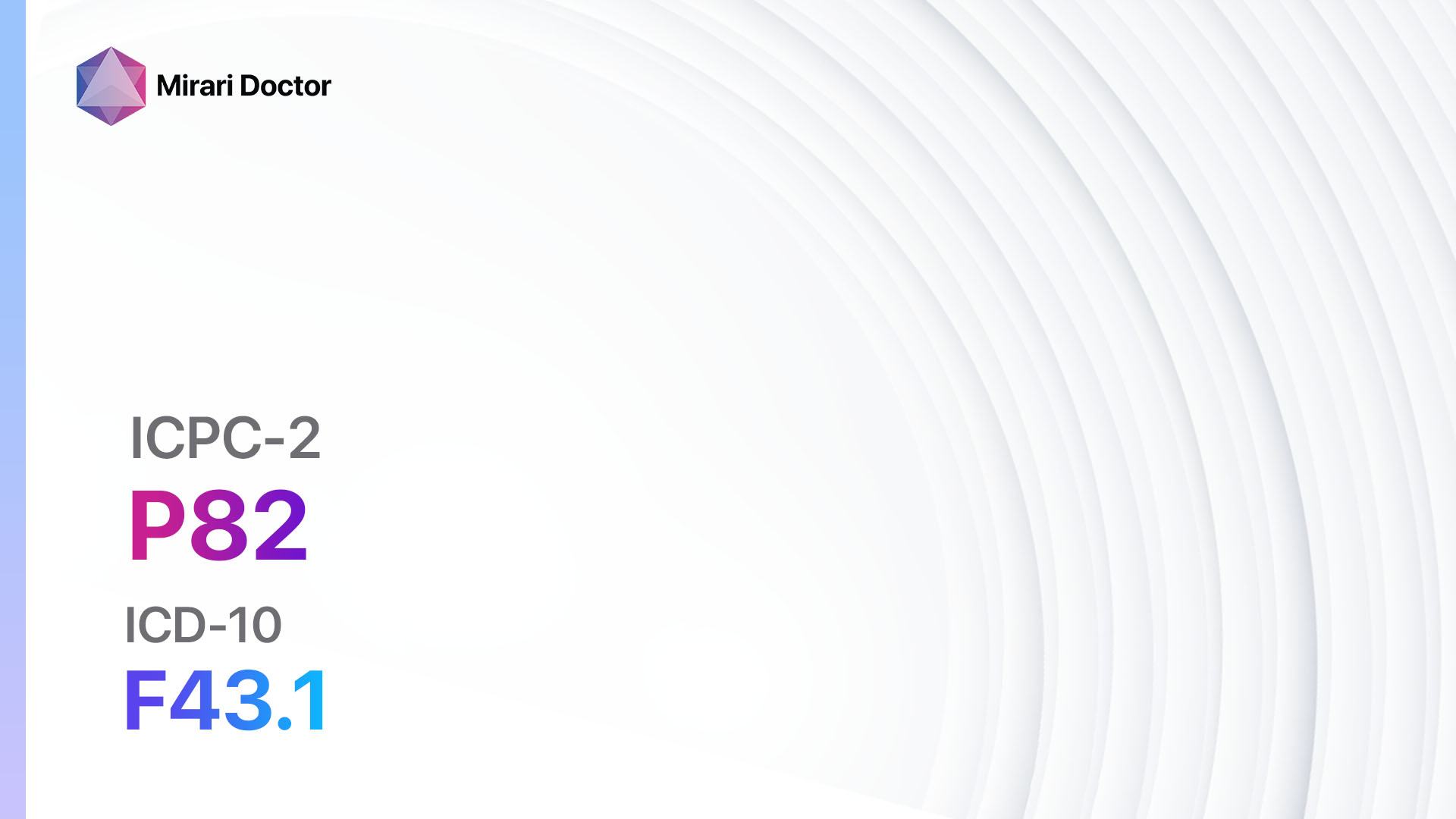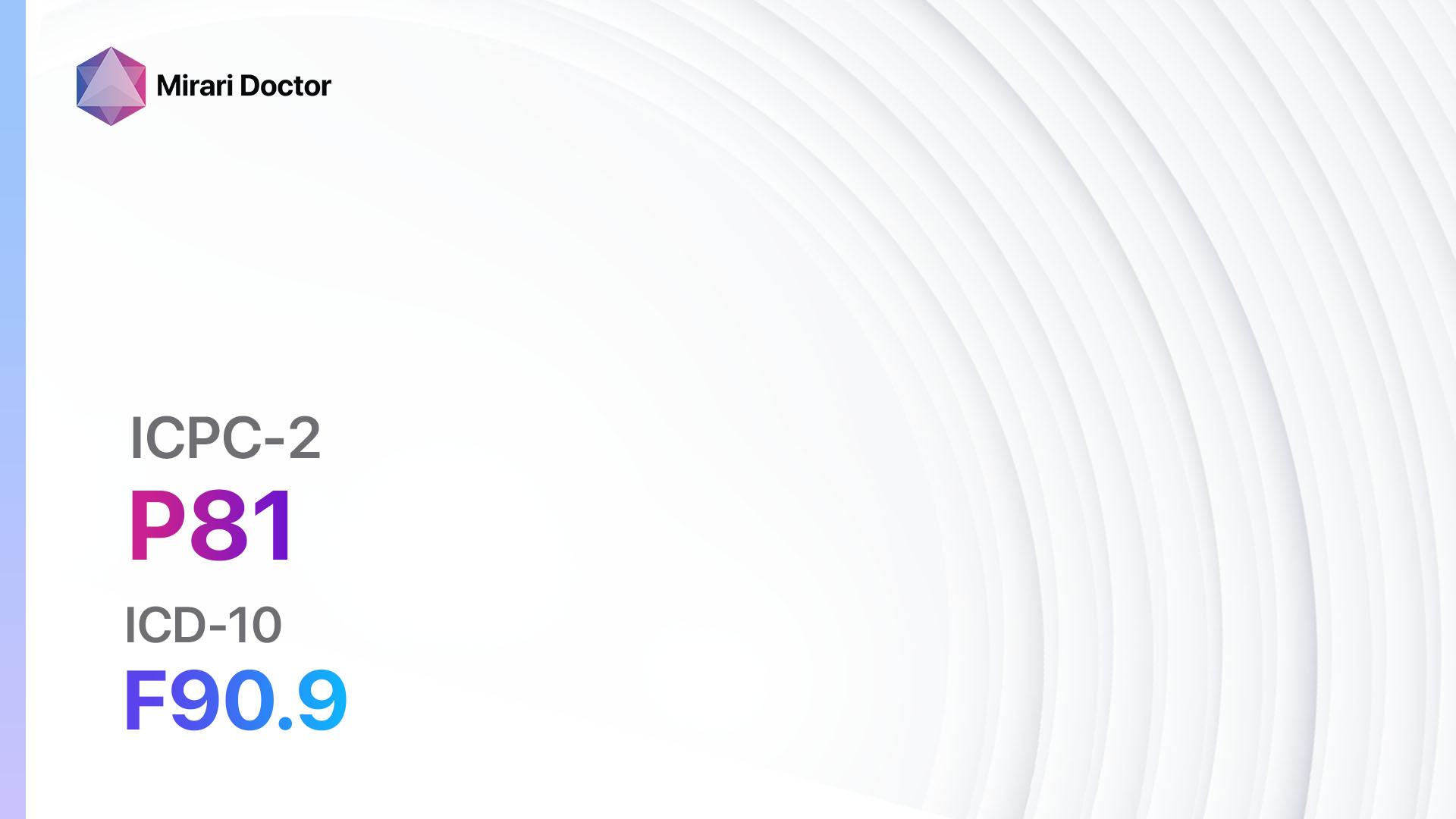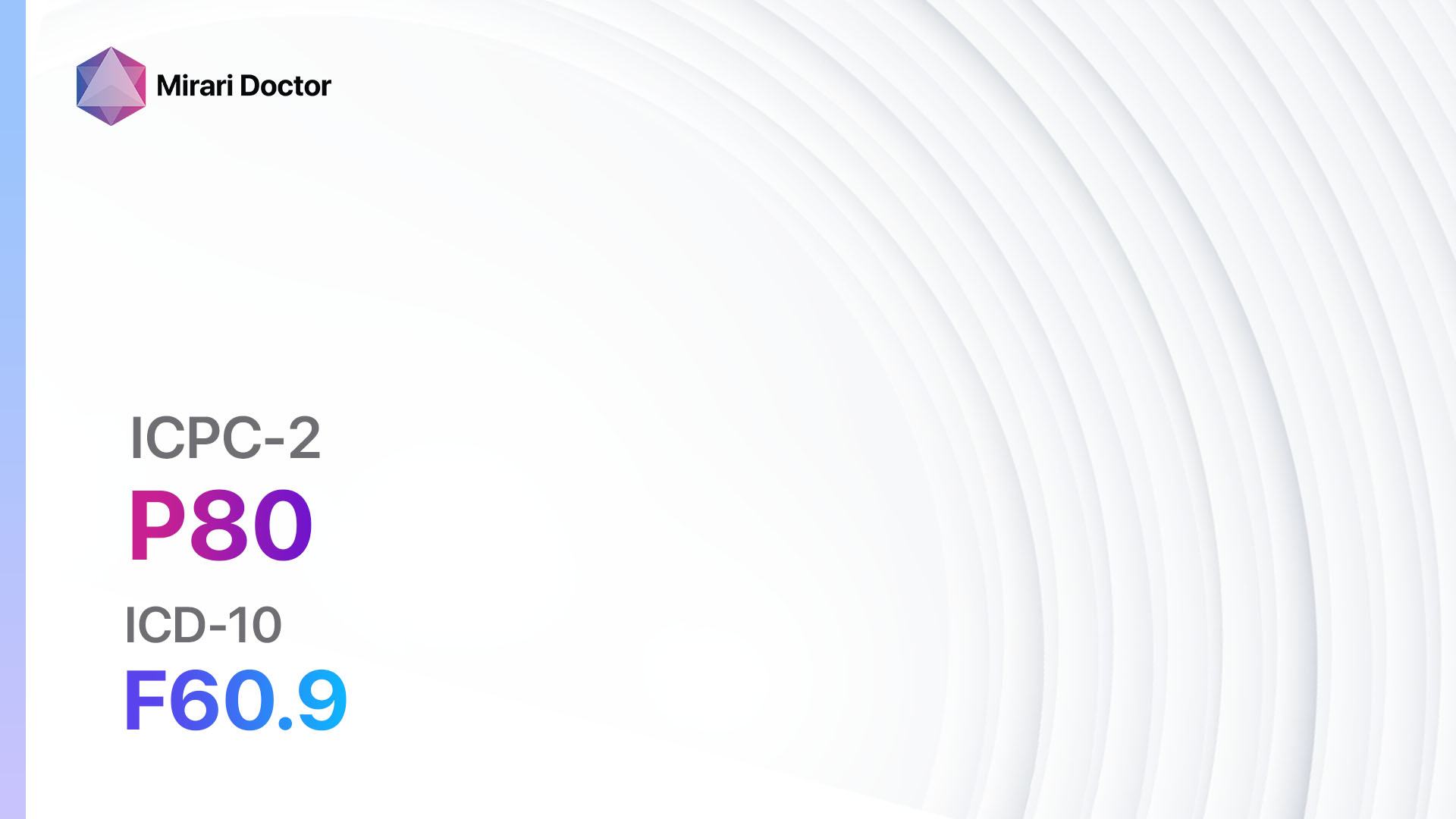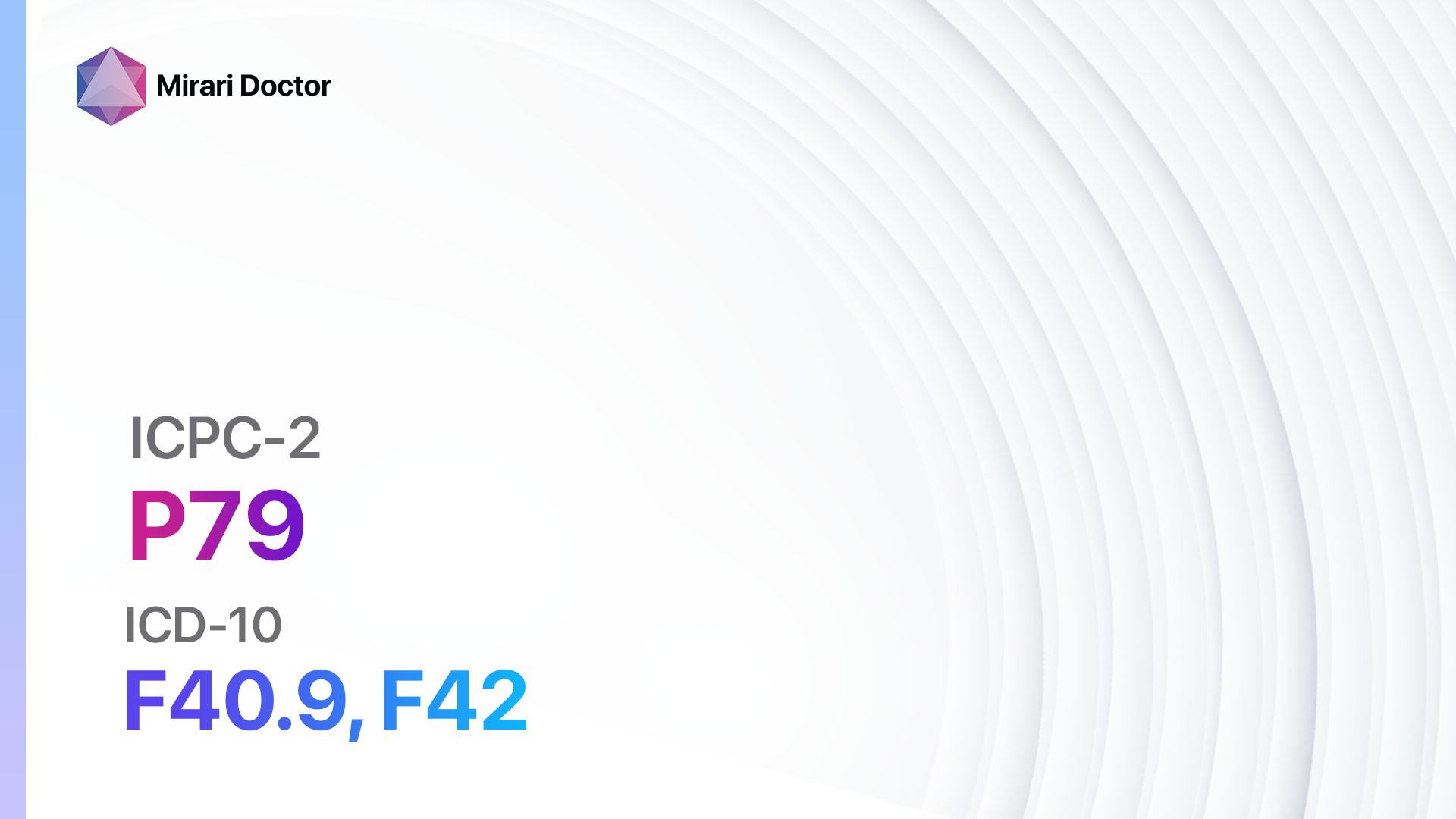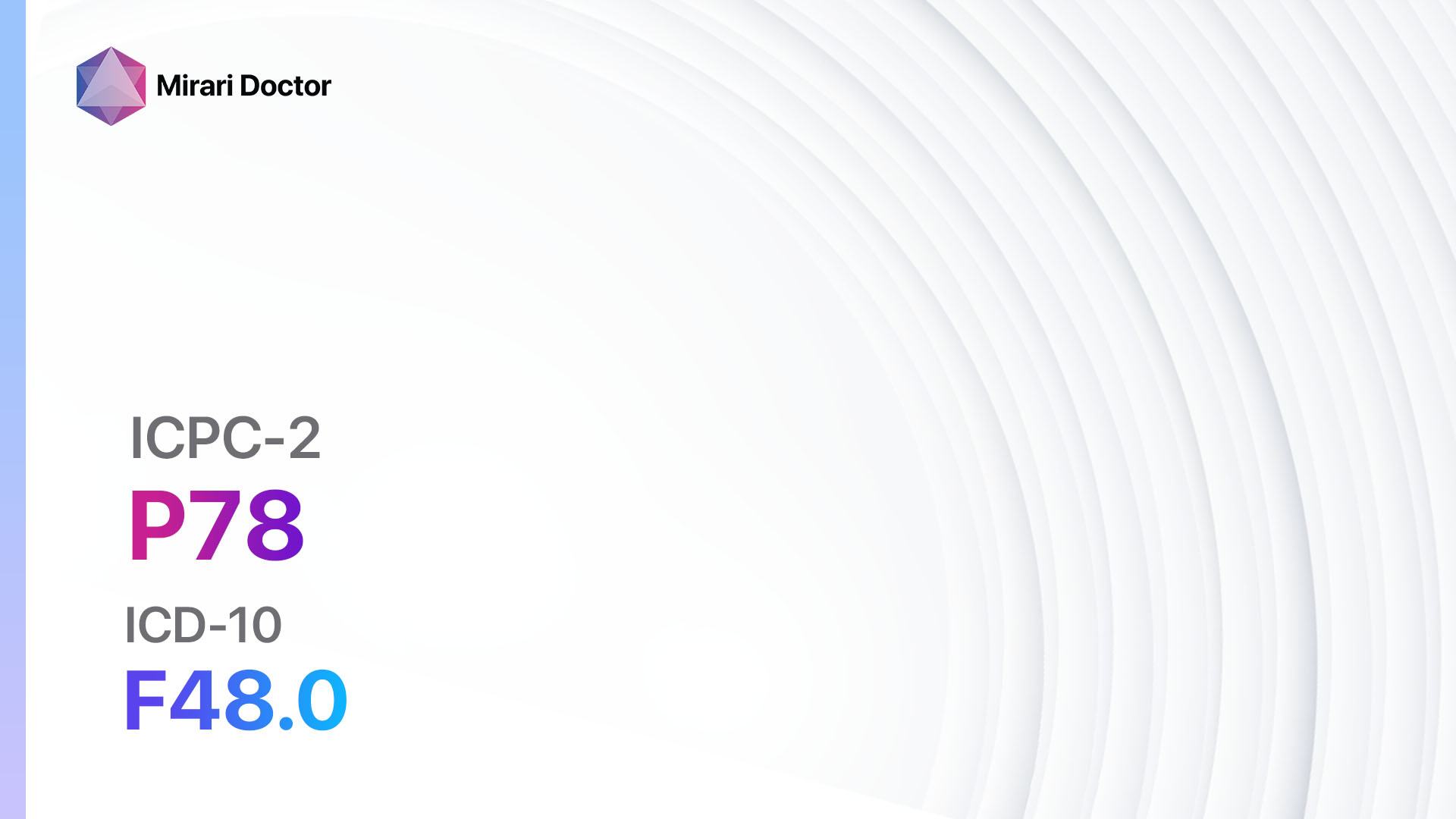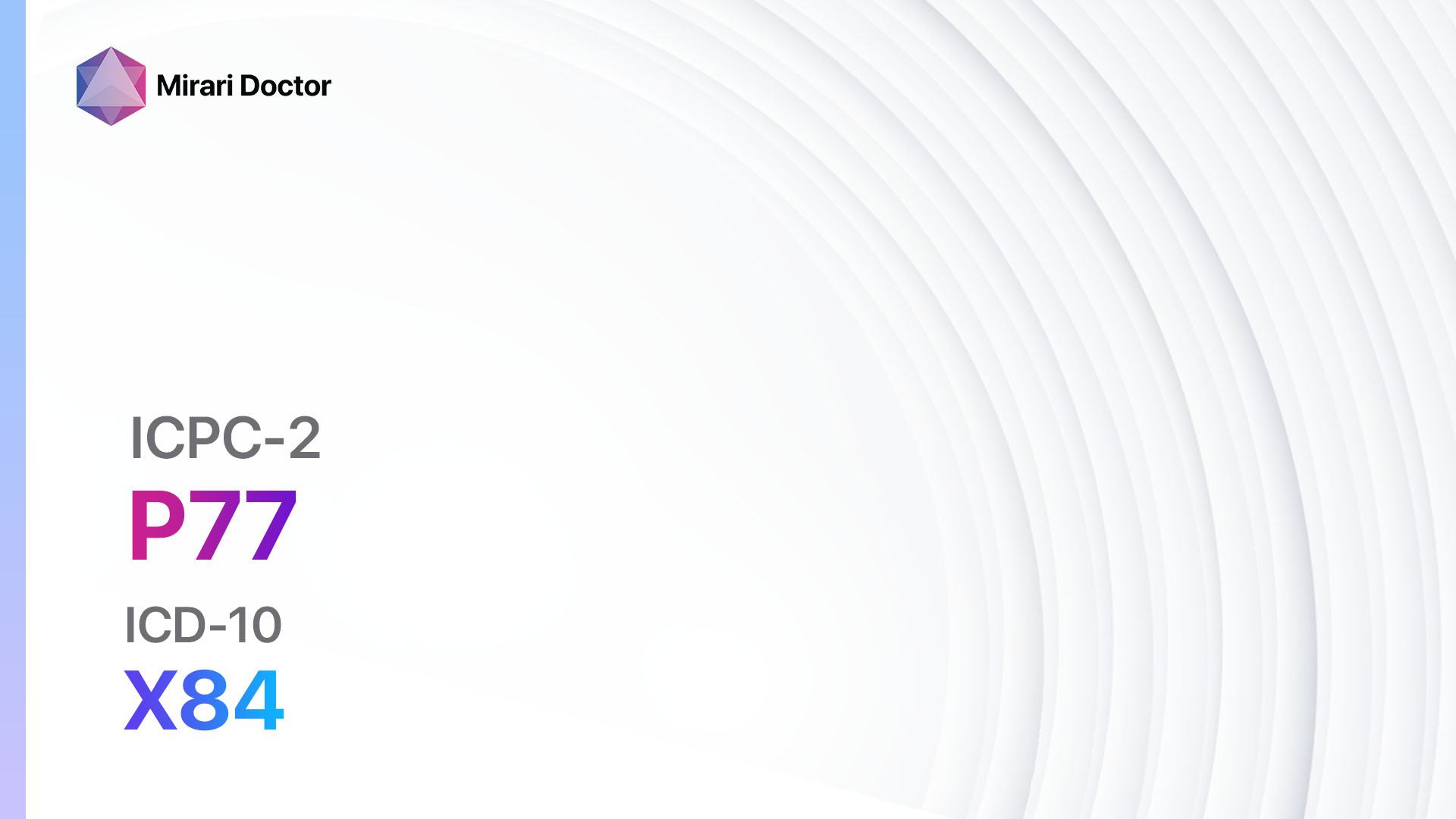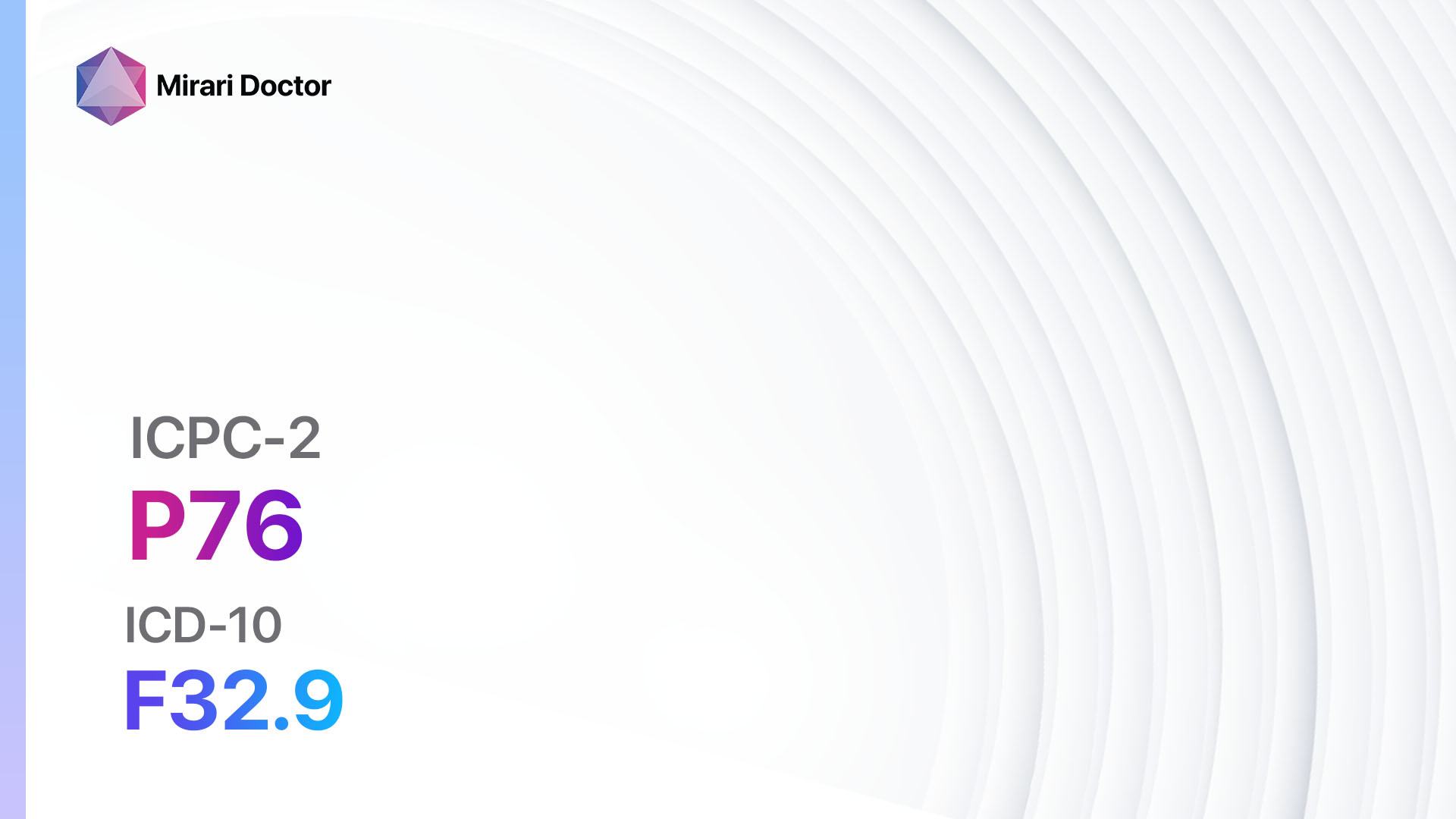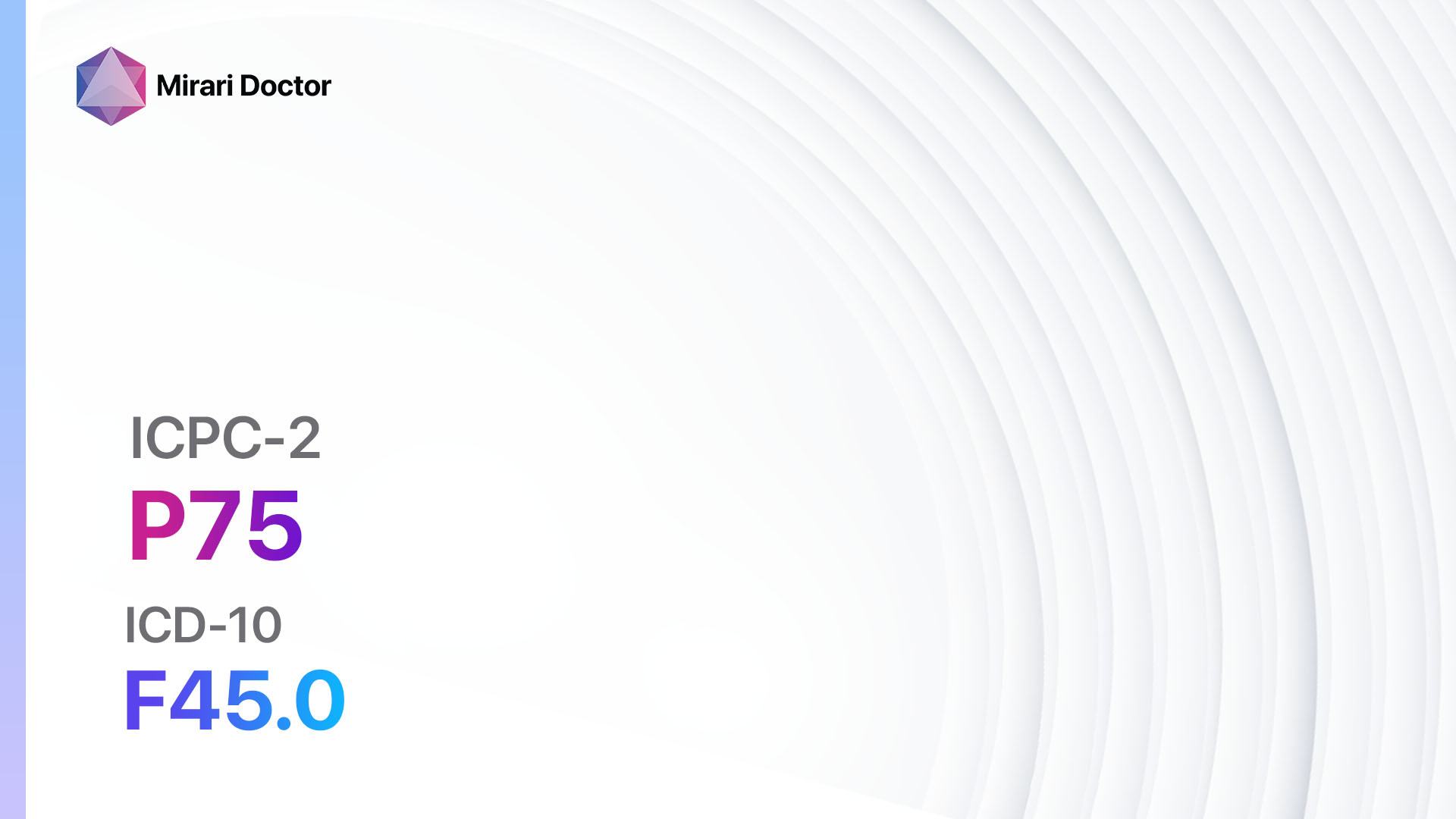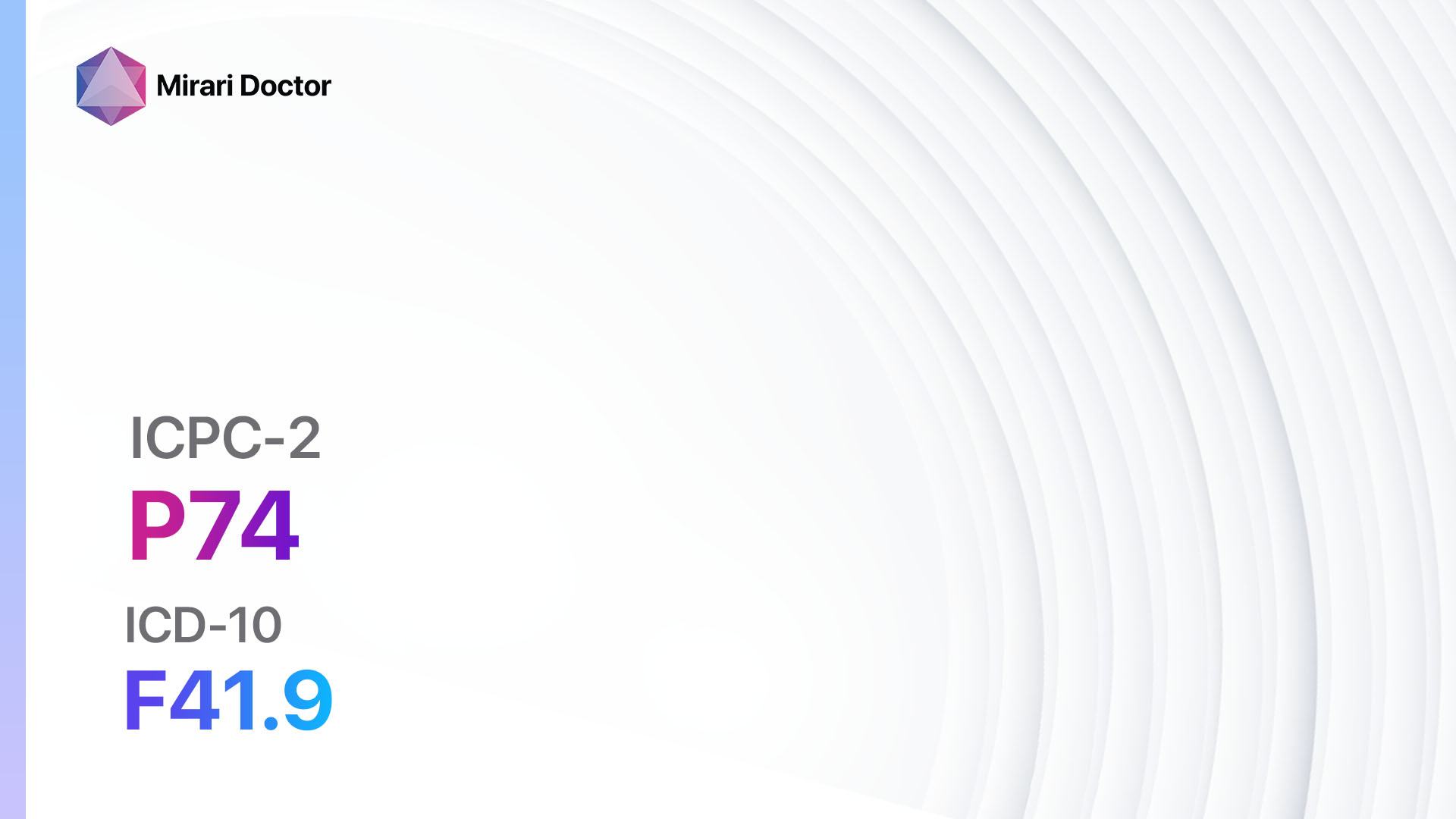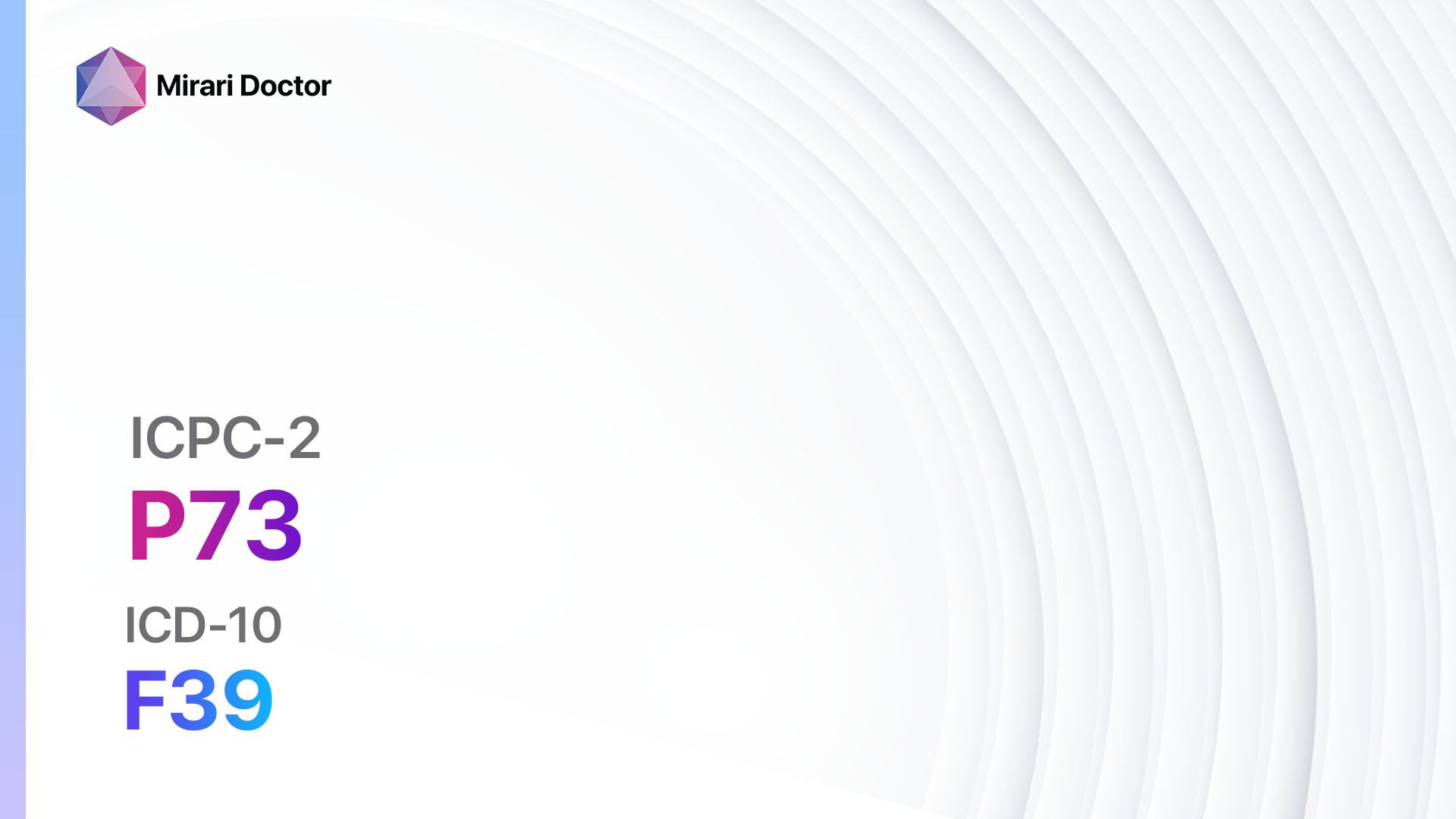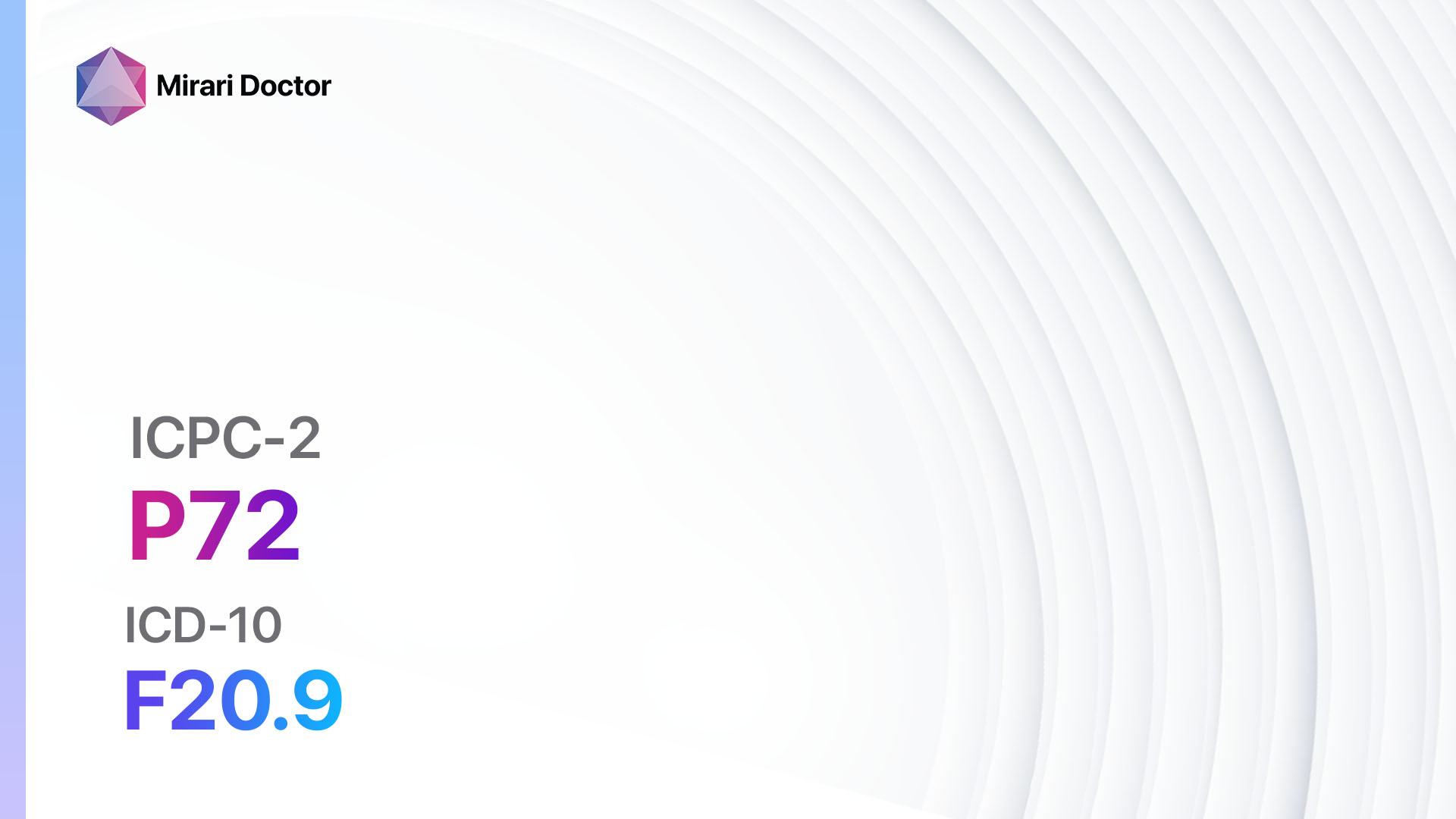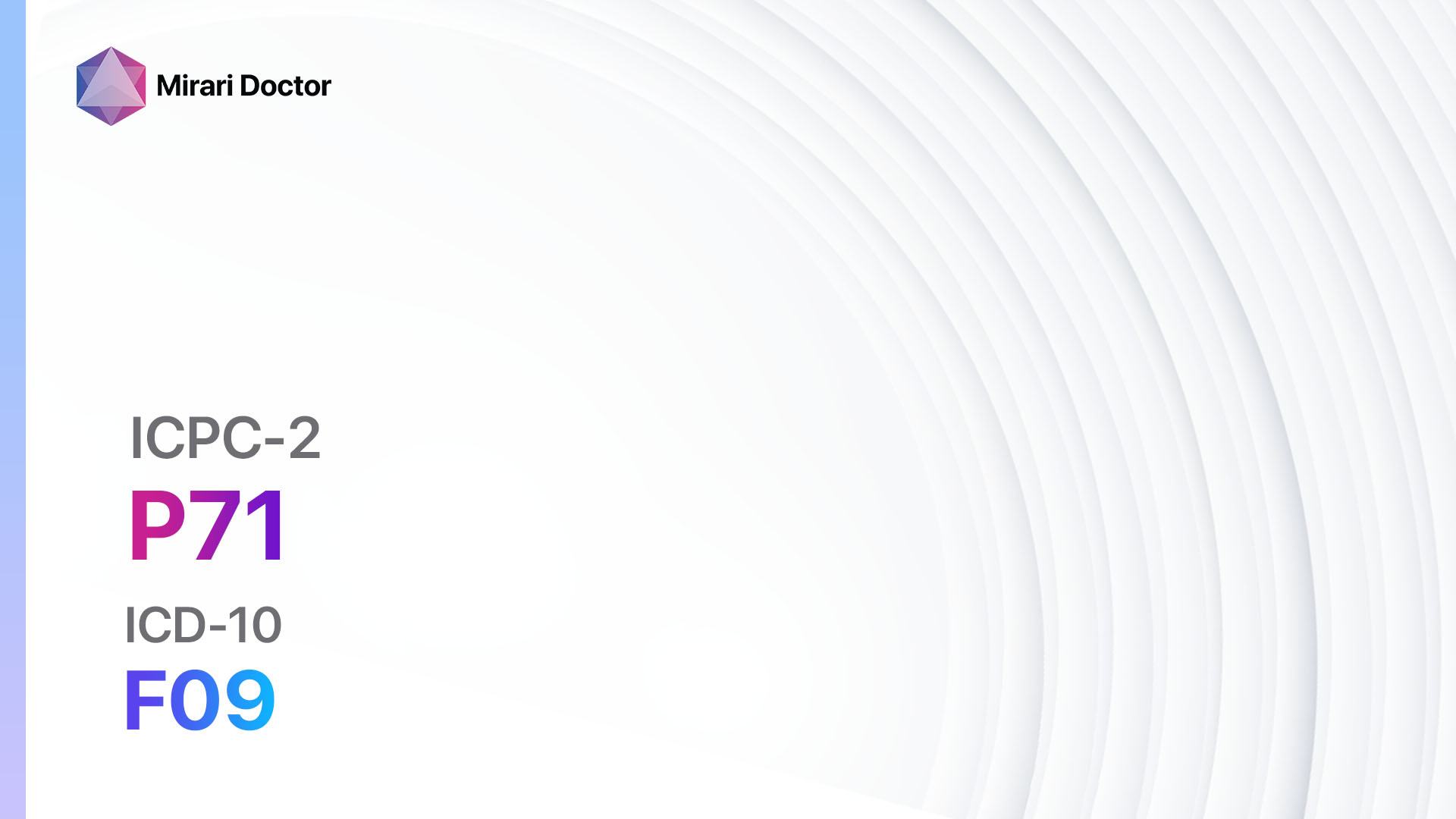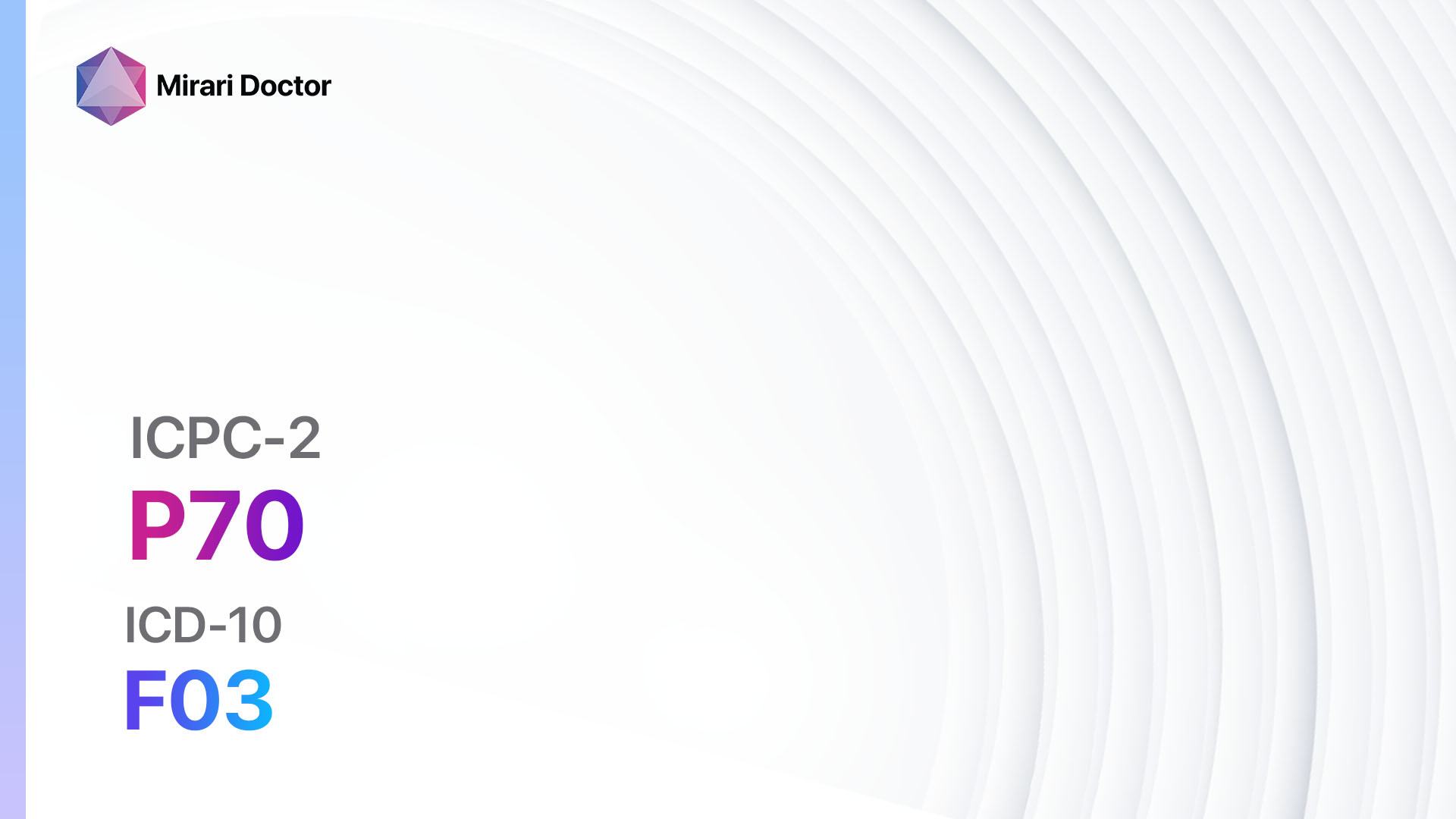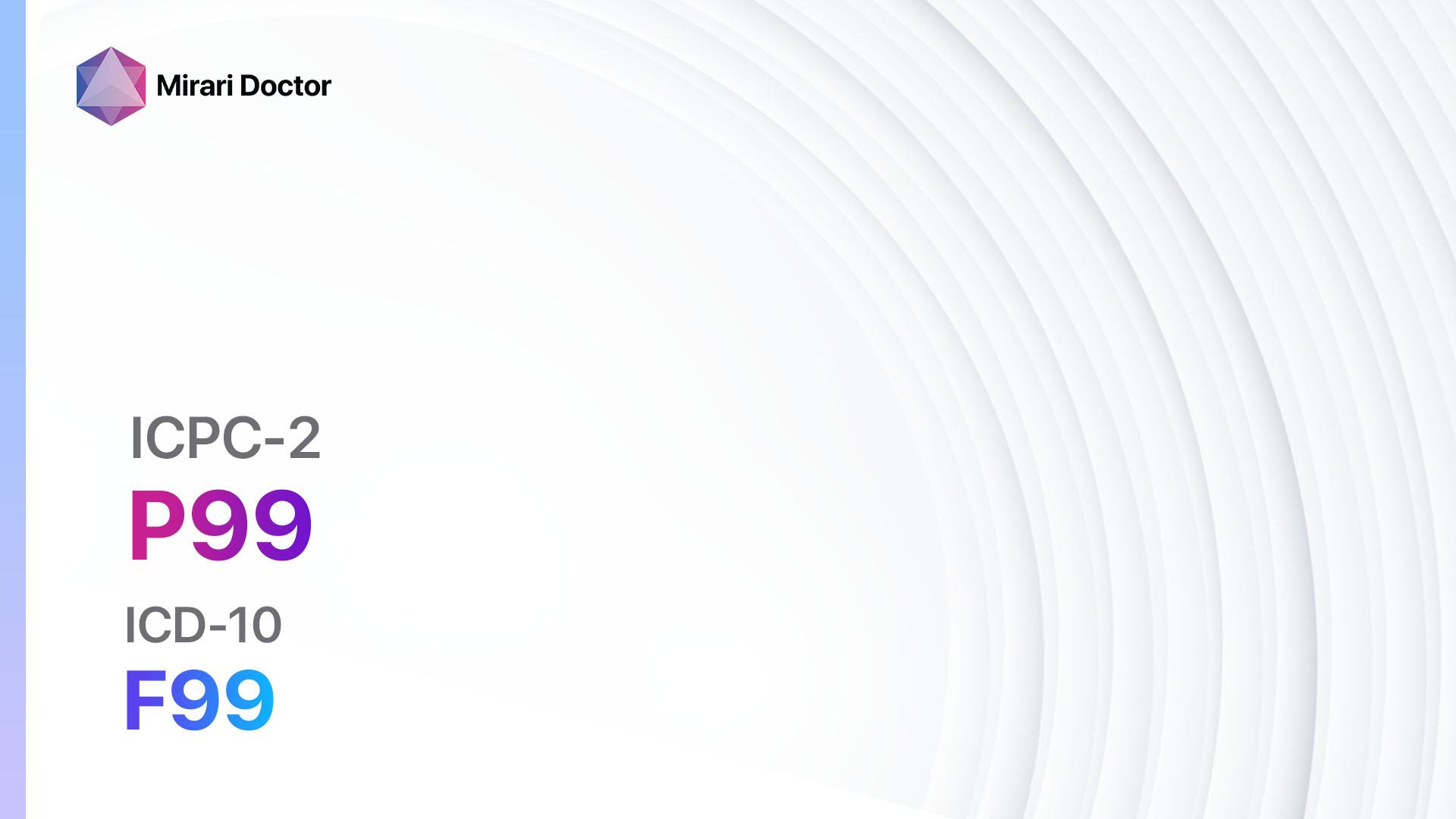
Introduction
Psychological disorders encompass a wide range of conditions that affect a person’s thoughts, emotions, and behaviors. While there are many well-known psychological disorders, there are also other disorders that do not fit into specific diagnostic categories. These “other” psychological disorders, classified under ICPC-2 code P99, require careful evaluation and management[1]. This guide aims to provide a comprehensive overview of the diagnostic and treatment approaches for psychological disorders, other (ICPC-2: P99).
Codes
- ICPC-2 Code: P99 Psychological disorders, other[2]
- ICD-10 Code: F99 Mental disorder, not otherwise specified[3]
Symptoms
- Emotional instability: Frequent mood swings, irritability, or emotional outbursts.
- Cognitive disturbances: Difficulty concentrating, memory problems, or confusion.
- Behavioral changes: Social withdrawal, changes in appetite or sleep patterns, or self-destructive behaviors.
- Psychotic symptoms: Delusions, hallucinations, or disorganized thinking.
- Anxiety symptoms: Excessive worry, panic attacks, or phobias.
- Impulsivity: Acting without thinking, engaging in risky behaviors, or difficulty controlling impulses[4].
Causes
- Genetic factors: Family history of mental illness or genetic predisposition.
- Environmental factors: Traumatic experiences, chronic stress, or substance abuse.
- Neurochemical imbalances: Imbalances in neurotransmitters such as serotonin, dopamine, or norepinephrine.
- Brain abnormalities: Structural or functional abnormalities in certain brain regions.
- Developmental factors: Early childhood experiences or disruptions in normal brain development[5].
Diagnostic Steps
Medical History
- Gather information about the patient’s personal and family medical history.
- Assess for any risk factors, such as a history of trauma or substance abuse.
- Evaluate the duration, severity, and progression of symptoms.
- Inquire about any co-existing medical conditions or medications that may contribute to the symptoms[6].
Physical Examination
- Perform a thorough physical examination to rule out any underlying medical conditions that may be causing or exacerbating the psychological symptoms.
- Pay attention to any physical signs that may indicate a specific psychological disorder, such as self-inflicted injuries or signs of malnutrition[7].
Laboratory Tests
- Complete blood count (CBC): To rule out any underlying medical conditions, such as anemia or infections.
- Thyroid function tests: To assess thyroid function, as thyroid abnormalities can contribute to mood disturbances.
- Urine drug screen: To detect any substance abuse that may be contributing to the symptoms.
- Toxicology screen: To identify any exposure to toxins or heavy metals that may be causing or exacerbating the symptoms[8].
Diagnostic Imaging
- Magnetic resonance imaging (MRI): To assess for any structural abnormalities in the brain.
- Computed tomography (CT) scan: To evaluate the brain for any abnormalities, such as tumors or bleeding.
- Positron emission tomography (PET) scan: To assess brain activity and identify any areas of abnormal functioning[9].
Other Tests
- Neuropsychological testing: To assess cognitive functioning, memory, and attention.
- Electroencephalogram (EEG): To evaluate brain wave patterns and detect any abnormalities.
- Psychological assessments: To gather information about the patient’s thoughts, emotions, and behaviors through standardized questionnaires or interviews[10].
Follow-up and Patient Education
- Schedule regular follow-up appointments to monitor the patient’s progress and adjust treatment as needed.
- Provide education to the patient and their family about the nature of the disorder, treatment options, and strategies for managing symptoms.
- Encourage the patient to engage in therapy or support groups to enhance their coping skills and social support.
Possible Interventions
Traditional Interventions
Medications:
Top 5 drugs for Psychological disorders, other (ICPC-2: P99):
- Selective serotonin reuptake inhibitors (SSRIs) (e.g., Fluoxetine, Sertraline, Escitalopram):
- Cost: Generic versions can be $3-$50/month.
- Contraindications: Hypersensitivity to SSRIs, concurrent use of monoamine oxidase inhibitors (MAOIs).
- Side effects: Nausea, headache, sexual dysfunction.
- Severe side effects: Serotonin syndrome, suicidal thoughts.
- Drug interactions: MAOIs, other serotonergic drugs.
- Warning: Increased risk of suicidal thoughts in children and young adults.
- Atypical antipsychotics (e.g., Risperidone, Olanzapine, Quetiapine):
- Cost: Generic versions can be $10-$100/month.
- Contraindications: Hypersensitivity to antipsychotics, dementia-related psychosis.
- Side effects: Weight gain, sedation, metabolic changes.
- Severe side effects: Neuroleptic malignant syndrome, tardive dyskinesia.
- Drug interactions: Other antipsychotics, drugs that prolong QT interval.
- Warning: Increased risk of mortality in elderly patients with dementia-related psychosis.
- Benzodiazepines (e.g., Diazepam, Lorazepam, Alprazolam):
- Cost: Generic versions can be $3-$50/month.
- Contraindications: Hypersensitivity to benzodiazepines, acute narrow-angle glaucoma.
- Side effects: Sedation, dizziness, dependence.
- Severe side effects: Respiratory depression, paradoxical reactions.
- Drug interactions: Other CNS depressants, opioids.
- Warning: Risk of dependence and withdrawal symptoms with long-term use.
- Mood stabilizers (e.g., Lithium, Valproate, Lamotrigine):
- Cost: Generic versions can be $10-$100/month.
- Contraindications: Hypersensitivity to mood stabilizers, severe renal or hepatic impairment.
- Side effects: GI upset, tremor, weight gain.
- Severe side effects: Renal toxicity, hepatotoxicity.
- Drug interactions: Other drugs that affect renal or hepatic function.
- Warning: Regular monitoring of renal and hepatic function required.
- Stimulants (e.g., Methylphenidate, Amphetamine):
- Cost: Generic versions can be $10-$100/month.
- Contraindications: Hypersensitivity to stimulants, history of substance abuse.
- Side effects: Insomnia, decreased appetite, increased heart rate.
- Severe side effects: Cardiovascular events, psychiatric symptoms.
- Drug interactions: MAOIs, other sympathomimetic drugs.
- Warning: Potential for abuse and dependence.
Alternative Drugs:
- Anticonvulsants (e.g., Gabapentin, Pregabalin): Used for mood stabilization and neuropathic pain.
- Tricyclic antidepressants (e.g., Amitriptyline, Nortriptyline): Used for depression and chronic pain.
- Monoamine oxidase inhibitors (MAOIs) (e.g., Phenelzine, Tranylcypromine): Used for treatment-resistant depression.
- Antipsychotic depot injections (e.g., Paliperidone, Risperidone): Long-acting formulations for maintenance treatment of psychosis.
- Anxiolytics (e.g., Buspirone, Hydroxyzine): Used for anxiety disorders.
Surgical Procedures:
- Deep brain stimulation (DBS): Involves implanting electrodes in specific brain regions to modulate abnormal neural activity. Cost: $50,000 to $100,000.
- Electroconvulsive therapy (ECT): Induces controlled seizures to alleviate severe depression or psychosis. Cost: $2,500 to $5,000 per session.
Alternative Interventions
- Acupuncture: May help reduce anxiety and improve overall well-being. Cost: $60-$120 per session.
- Mindfulness meditation: Can help reduce stress and improve emotional regulation. Cost: Varies, often free or low-cost.
- Art therapy: Utilizes creative expression to promote self-discovery and emotional healing. Cost: Varies depending on the setting and duration.
- Exercise therapy: Regular physical activity has been shown to improve mood and reduce symptoms of depression. Cost: Varies, often free or low-cost.
- Music therapy: Engaging in music-related activities can promote relaxation and emotional expression. Cost: Varies depending on the setting and duration.
Lifestyle Interventions
- Cognitive-behavioral therapy (CBT): A type of psychotherapy that helps individuals identify and change negative thought patterns and behaviors. Cost: $100-$200 per session.
- Support groups: Provide a supportive environment for individuals to share experiences and learn coping strategies. Cost: Often free or low-cost.
- Sleep hygiene: Establishing a regular sleep schedule and practicing good sleep habits can improve overall well-being. Cost: Free.
- Stress management techniques: Learning and practicing stress reduction techniques, such as deep breathing or mindfulness, can help manage symptoms. Cost: Varies, often free or low-cost.
- Healthy diet: Consuming a balanced diet rich in fruits, vegetables, and whole grains can support overall mental health. Cost: Varies depending on food choices.
It is important to note that the cost ranges provided are approximate and may vary depending on the location and availability of the interventions. Additionally, the choice of intervention should be tailored to the individual’s specific needs and preferences, and it is recommended to consult with a healthcare professional for personalized treatment recommendations.
Mirari Cold Plasma Alternative Intervention
Understanding Mirari Cold Plasma
- Safe and Non-Invasive Treatment: Mirari Cold Plasma is a safe and non-invasive treatment option for various skin conditions. It does not require incisions, minimizing the risk of scarring, bleeding, or tissue damage.
- Efficient Extraction of Foreign Bodies: Mirari Cold Plasma facilitates the removal of foreign bodies from the skin by degrading and dissociating organic matter, allowing easier access and extraction.
- Pain Reduction and Comfort: Mirari Cold Plasma has a local analgesic effect, providing pain relief during the treatment, making it more comfortable for the patient.
- Reduced Risk of Infection: Mirari Cold Plasma has antimicrobial properties, effectively killing bacteria and reducing the risk of infection.
- Accelerated Healing and Minimal Scarring: Mirari Cold Plasma stimulates wound healing and tissue regeneration, reducing healing time and minimizing the formation of scars.
Mirari Cold Plasma Prescription
Video instructions for using Mirari Cold Plasma Device – P99 Psychological disorders, other (ICD-10:F99)
| Mild | Moderate | Severe |
| Mode setting: 2 (Wound Healing) Location: 7 (Neuro system & ENT) Morning: 15 minutes, Evening: 15 minutes |
Mode setting: 2 (Wound Healing) Location: 7 (Neuro system & ENT) Morning: 30 minutes, Lunch: 30 minutes, Evening: 30 minutes |
Mode setting: 2 (Wound Healing) Location: 7 (Neuro system & ENT) Morning: 30 minutes, Lunch: 30 minutes, Evening: 30 minutes |
| Mode setting: 7 (Immunotherapy) Location: 1 (Sacrum) Morning: 15 minutes, Evening: 15 minutes |
Mode setting: 7 (Immunotherapy) Location: 1 (Sacrum) Morning: 30 minutes, Lunch: 30 minutes, Evening: 30 minutes |
Mode setting: 7 (Immunotherapy) Location: 1 (Sacrum) Morning: 30 minutes, Lunch: 30 minutes, Evening: 30 minutes |
| Total Morning: 30 minutes approx. $5 USD, Evening: 30 minutes approx. $5 USD |
Total Morning: 60 minutes approx. $10 USD, Lunch: 60 minutes approx. $10 USD, Evening: 60 minutes approx. $10 USD, |
Total Morning: 60 minutes approx. $10 USD, Lunch: 60 minutes approx. $10 USD, Evening: 60 minutes approx. $10 USD, |
| Usual treatment for 7-60 days approx. $70 USD – $600 USD | Usual treatment for 6-8 weeks approx. $1,260 USD – $1,680 USD |
Usual treatment for 3-6 months approx. $2,700 USD – $5,400 USD
|
 |
|
Use the Mirari Cold Plasma device to treat Psychological disorders, other effectively.
WARNING: MIRARI COLD PLASMA IS DESIGNED FOR THE HUMAN BODY WITHOUT ANY ARTIFICIAL OR THIRD PARTY PRODUCTS. USE OF OTHER PRODUCTS IN COMBINATION WITH MIRARI COLD PLASMA MAY CAUSE UNPREDICTABLE EFFECTS, HARM OR INJURY. PLEASE CONSULT A MEDICAL PROFESSIONAL BEFORE COMBINING ANY OTHER PRODUCTS WITH USE OF MIRARI.
Step 1: Cleanse the Skin
- Start by cleaning the affected area of the skin with a gentle cleanser or mild soap and water. Gently pat the area dry with a clean towel.
Step 2: Prepare the Mirari Cold Plasma device
- Ensure that the Mirari Cold Plasma device is fully charged or has fresh batteries as per the manufacturer’s instructions. Make sure the device is clean and in good working condition.
- Switch on the Mirari device using the power button or by following the specific instructions provided with the device.
- Some Mirari devices may have adjustable settings for intensity or treatment duration. Follow the manufacturer’s instructions to select the appropriate settings based on your needs and the recommended guidelines.
Step 3: Apply the Device
- Place the Mirari device in direct contact with the affected area of the skin. Gently glide or hold the device over the skin surface, ensuring even coverage of the area experiencing.
- Slowly move the Mirari device in a circular motion or follow a specific pattern as indicated in the user manual. This helps ensure thorough treatment coverage.
Step 4: Monitor and Assess:
- Keep track of your progress and evaluate the effectiveness of the Mirari device in managing your Psychological disorders, other. If you have any concerns or notice any adverse reactions, consult with your health care professional.
Note
This guide is for informational purposes only and should not replace the advice of a medical professional. Always consult with your healthcare provider or a qualified medical professional for personal advice, diagnosis, or treatment. Do not solely rely on the information presented here for decisions about your health. Use of this information is at your own risk. The authors of this guide, nor any associated entities or platforms, are not responsible for any potential adverse effects or outcomes based on the content.
Mirari Cold Plasma System Disclaimer
- Purpose: The Mirari Cold Plasma System is a Class 2 medical device designed for use by trained healthcare professionals. It is registered for use in Thailand and Vietnam. It is not intended for use outside of these locations.
- Informational Use: The content and information provided with the device are for educational and informational purposes only. They are not a substitute for professional medical advice or care.
- Variable Outcomes: While the device is approved for specific uses, individual outcomes can differ. We do not assert or guarantee specific medical outcomes.
- Consultation: Prior to utilizing the device or making decisions based on its content, it is essential to consult with a Certified Mirari Tele-Therapist and your medical healthcare provider regarding specific protocols.
- Liability: By using this device, users are acknowledging and accepting all potential risks. Neither the manufacturer nor the distributor will be held accountable for any adverse reactions, injuries, or damages stemming from its use.
- Geographical Availability: This device has received approval for designated purposes by the Thai and Vietnam FDA. As of now, outside of Thailand and Vietnam, the Mirari Cold Plasma System is not available for purchase or use.
References
- Allsopp, K., Read, J., Corcoran, R., & Kinderman, P. (2019). Heterogeneity in psychiatric diagnostic classification. Psychiatry Research, 279, 15-22.
- WONCA International Classification Committee. (1998). ICPC-2: International Classification of Primary Care. Oxford University Press, USA.
- World Health Organization. (2019). International Statistical Classification of Diseases and Related Health Problems (11th ed.).
- American Psychiatric Association. (2013). Diagnostic and Statistical Manual of Mental Disorders (DSM-5®). American Psychiatric Pub.
- Smoller, J. W., Andreassen, O. A., Edenberg, H. J., Faraone, S. V., Glatt, S. J., & Kendler, K. S. (2019). Psychiatric genetics and the structure of psychopathology. Molecular Psychiatry, 24(3), 409-420.
- Sadock, B. J., Sadock, V. A., & Ruiz, P. (2014). Kaplan and Sadock’s Synopsis of Psychiatry: Behavioral Sciences/Clinical Psychiatry. Lippincott Williams & Wilkins.
- Gabbard, G. O. (2014). Gabbard’s Treatments of Psychiatric Disorders. American Psychiatric Pub.
- Freudenreich, O., Kontos, N., & Nejad, S. H. (2020). The Evaluation and Management of Patients with Psychotic Disorders in Primary Care. Medical Clinics, 104(3), 561-577.
- Lui, S., Zhou, X. J., Sweeney, J. A., & Gong, Q. (2016). Psychoradiology: the frontier of neuroimaging in psychiatry. Radiology, 281(2), 357-372.
- Wright, J. H., Basco, M. R., & Thase, M. E. (2017). Learning Cognitive-Behavior Therapy: An Illustrated Guide. American Psychiatric Pub.
Related articles
Made in USA


